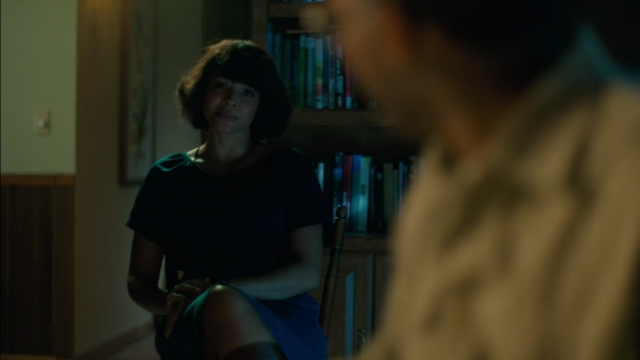. . .out of history into history and the awful responsibility of Time. (Robert Penn Warren)
Having launched the season last week with a steady series of plot-bombs, True Detective slows down for this episode and becomes more of a standard procedural–really three of them, one for each timeline. Clues get found and moves get made in each one: in 1980, we get the first clues about where Will Purcell was killed (and our guess last week that D&D was going to be a part of the story was right); in 1990, West (Stephen Dorff) gets put in charge of the Purcell re-investigation and Amelia finds out more about where Julie Purcell showed up; and in 2015, the TV producer (Sarah Gadon) makes Wayne, and us, more aware of the flaws in the 1980 investigation.
This hour moves more slowly and with less overt interest; partly because TV veteran Daniel Sackheim is good but not on the level of Jeremy Saulnier, partly because not a lot happens and what does happen is fairly predictable. (Will Wayne’s trip to a Walmart in 1990 with his kids result in a scare over one of them disappearing? You make the call.) That’s often a weakness of procedurals, and as long as this doesn’t persist for more than two episodes, it doesn’t seriously damage the pacing of the series.
The interest here comes not from the plot but from the relationships of the characters, and how Pizzolatto uses the triple time frame to move between all stages of those relationships. We start with West in 1990 recalling the 1980 investigation with Wayne, and saying that he’s lost touch with him. Dorff was mostly supporting in the first two episodes, but we spend more time with him here and he’s up to the challenge; Dorff plays West as a thoughtful and somewhat sorrowful detective, but also the kind of man who would almost never talk about it. (Marty Hart would never have to beg this guy to shut the fuck up.) Dorff also gets a remarkable moment with Scoot McNairy, playing Tom Purcell, the father; in 1990, he’s become a member of Alcoholics Anonymous, a committed Christian, grateful to West for getting him out of trouble five years earlier, and it’s clear that hearing that Julie is alive threatens to shatter all of that. Without resorting to any kind of overt tricks, McNairy plays a desperation that’s all through his body; when he leads West in prayer, West gently moves from curiosity to acceptance, as he realizes (and so do we) that this is how Tom lives in the world now.
Considering how religion was treated in season one, that’s a big shift for True Detective, pointing to the major relationship of the hour and the deepening thematic concerns. We see Amelia and Wayne at all stages of their love: walking the fields in 1980 looking for clues (which leads to a conversation about Robert Penn Warren, tracking, and Wayne asking her to dinner), staking out the Walgreen’s in 1990 (which gives them both a sense of, as Miller said last week, as co-conspirators and as lovers), getting into an argument not long after, and finally with her ghost showing up in 2015. (That last moment calls back Vince Vaughn’s final scene in the previous season, and I’m glad it did; Pizzolatto’s theatrical instincts, letting characters occupy the same space without regard for realism, have remained strong.) The acting and directing in these scenes are at their best and most subtle; after Wayne asks Amelia to dinner, Sackheim holds on them for just a moment and then cuts away before she can answer. We don’t need the answer, we know what it is; but the cut introduces a sense of foreboding. The dinner might end well, but the story might not.
The Warren discussion in 1980 brings up what feels like the theme of the season: why, Wayne asks, does Warren say you must not name Time? Thinking about it, Amelia sez it’s because we live in Time, and naming something separates you from it. (Wayne replies that he thinks it’s like “the Hebrews” not naming God–and I’ll just add that I think these two answers are the same.) The next scene jumps to 1990 as Wayne sez he can’t read Amelia’s book about the case–“kept seeing my name.” Wayne is too much part of the events to see them named, to see them represented; and then we’re discovering in the 2015 sequences that he already separated himself from what had happened.
Carmen Ejogo has the showiest moment as Amelia’s ghost, moving more into focus visually and with her words; she’s just slightly gleeful, free of whatever responsibility that Wayne still has to carry, and she still clearly loves him. (Anyone who has coped with the death of someone they love knows that the relationship doesn’t end with that death.) Her language is different from everyone else’s, more florid and poetic; at times she sounds like Neil Gaiman’s Death. (“What do I have to lose?” Wayne asks; “Everything, the same as everybody else,” she replies.) She’s interrogating Wayne, and in fact the whole episode moves through a series of people questioning each other, sometimes hostile, sometimes not. There are also some subtle connections as we move between scenes (when a character describes a black man and a white woman, the next thing we see in 2015 is Wayne and the producer). It continues the essential feeling of the first two episodes, that we’re moving through Wayne’s failing memory, where connections get made, revisited, and possibly lost. The driving question of the series is not what will happen next, but what will Wayne remember next?


